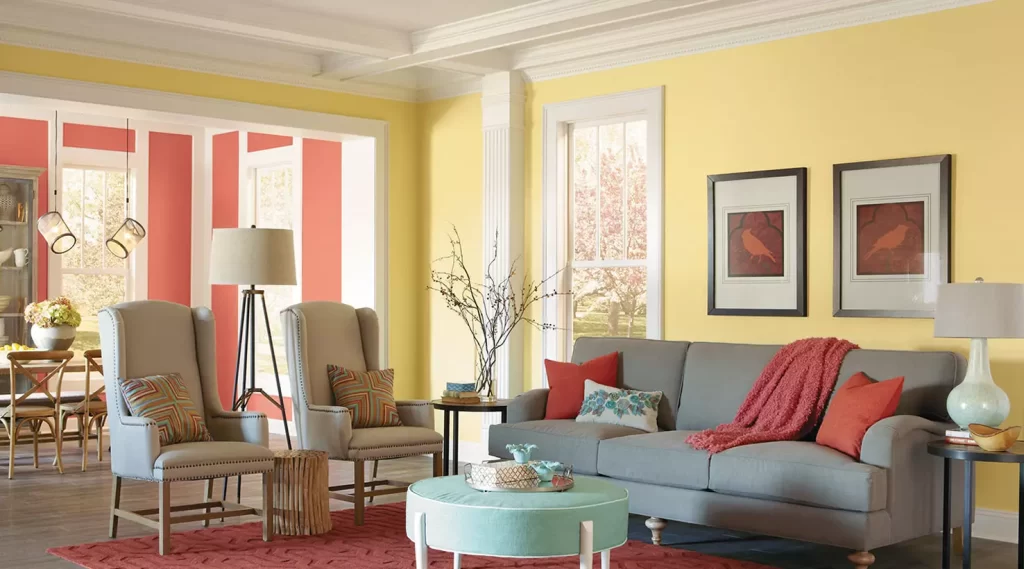Finding your ideal partner takes some work; so when it comes to painting a home, selecting a color scheme is equally essential.
One way to ensure that the paint colors in your home flow nicely from room to room is to consider sightlines. This involves identifying which rooms can be seen from other spaces and what impact their colors will have on one another.
Black and White
Black and white is an timeless color combination, providing the opportunity for any room’s design aesthetic – be it clean and minimalistic or bold and striking. Additionally, it serves as an effective background that sets other hues off or can serve as an eye-catching accent in an otherwise subdued space.
Brown is an earthy hue that pairs well with almost every shade of black, thanks to its warm tones that balance out the coldness of black while its natural wood characteristics complementing an earthy style that many homeowners appreciate.
This monochromatic blueberry-inspired color scheme works because each shade builds upon one another to form an integrated palette that still offers ample contrast. This type of scheme is frequently employed by charts and graphs; however, it can also serve to establish themes when high contrast levels aren’t required.
Aqua Blue and Mellow Yellow
An inviting combination of soft yellow and light blue tones creates an airy space, making for a refreshing yet airy setting. Perfect for modern or classic designs.
Reminiscent of sun-baked plaster and beachfront sunsets, this color scheme conjures images of relaxation and vacation time spent relaxing by the seaside. Use it in a bedroom or living space to bring vacation-like ambience into your own home!
Yellow can be overwhelming for certain spaces. To keep it from dominating your design, balance its brightness with complementary warm brown or deep red shades – such as warm brown and deep red are excellent ways to ground glossy blacks and whites like found here in this sleek kitchen – as well as woodsy greens or teal variations; creating an earthy palette. It also complements rustic or country homes well!
Taupe and Aqua Blue
Aqua blue goes well with pink, yellow-orange and coral colors as well as shades of green such as pine needle, sage and teal.
Use monochromatic tones such as taupe and tan for an elegant effect; layer textured fabrics with decor pieces in different hues for optimal effect. Throw blankets and pillows of various shades may add another dimension of dimension.
Aqua goes well with natural wood tones, patina raw brass accents and terra cotta accessories. For an eye-catching statement piece, use darker hues of aqua. South-facing rooms with ample natural lighting benefit greatly from having cool undertones counterbalance the warmth of sunlight; its soothing undertones create a tranquil ambiance and can also be combined with feature colors from either navy or red families – recommended by Impressive Interior Design.
White and Black
If you want a sophisticated yet high-contrast palette, black and white should be your choice. This classic combination works seamlessly with almost any accent color; silver appliances or wooden furniture add warmth without making the color scheme seem clinical.
For an eye-catching yet fresher style in your kitchen or breakfast nook, mango orange with crisp white can add an exciting splash of color. You’ll be sure to impress guests! This bold combination creates an eye-catching yet modern aesthetic in the space.
Use an analogous color scheme (colors that sit next to each other on the color wheel) as another means of working with this pairing, keeping your palette light and neutral while adding in some contrasting shades for more dramatic effects.
White and Yellow
Yellow and white colors form an easy pairing, often connoting feelings of joy, motivation and purity. As such, these hues are popular choices in design schemes ranging from logos and branding campaigns to home interiors.
Yellow and white provide a striking visual contrast without becoming visually tiresome. Mixtures of these hues can also produce more nuanced colors such as pale pinks and off-whites for even greater visual impact.
Yellow pairs well with brown hues that evoke wood grain, lending warmth and natural appeal to any space. A tetradic color scheme using four opposing pairs placed equidistant from one another on the color wheel can be especially helpful when trying to emphasize warmth within browns and yellows.







More Stories
Designing for Multi-Functionality: Spaces That Adapt to Your Needs
Icons in Focus
How to Design a Bathroom